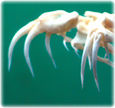Difference between revisions of "Snake Teeth"
(New page: {{unfinished}} The arrangement and number of teeth is extremely species-specific. Some species of snake have virtually no teeth while others have very highly developed teeth. The function ...) |
|||
| (13 intermediate revisions by 4 users not shown) | |||
| Line 1: | Line 1: | ||
| − | {{ | + | {{OpenPagesTop}} |
| − | The arrangement and number of teeth is extremely species | + | ==Introduction== |
| + | The arrangement and number of teeth is extremely species specific. Some species of snake have virtually no teeth while others have very highly developed teeth. The function of undifferentiated teeth is to draw food items into the mouth rather than to chew. Teeth continue to be replaced throughout life, including the fangs. | ||
| − | *''' | + | * '''For more information on captive snake diets, see''' [[Snake Feeding and Digestion]]. |
| − | + | Six rows of teeth are generally present in snakes commonly seen in the pet trade, one row on each side of the lower jaws and two rows on each side of the upper jaws. | |
| + | ==Morphology== | ||
| + | Teeth are of the [[Pleurodont dentition|pleurodont]] type and are generally not differentiated ([[Aglyphous|aglyphous]]) except in venomous snakes or in species with specialised feeding habits that have fangs. None have conventional molars, premolars or incisors. | ||
| − | * | + | ==Fangs== |
| + | Fangs may be located at the front or the rear of the mouth. Front fangs are either fixed ([[Prosthoglyphous|prosthoglyphous]]) or moveable ([[Solenoglyphous|solenoglyphous]]). They are attached to the maxilla and may be shed monthly. Reserve fangs are present behind each functional fang and these grow in size, move forward and ankylose with the maxilla. Rear fangs may be one or two pairs of enlarged teeth positioned caudally in the mouth ([[Opisthoglyphous|opisthoglyphous]]) or the unusual arrangement seen in [[Xenodontinae|xenodontine dentition]]. When not in use, a membranous flap usually covers the fangs. | ||
| + | *In [[Viperidae|vipers]] and [[Pit viper|pit vipers]], fangs fold caudodorsally and are sheathed when the mouth is closed. | ||
| + | *In [[Elapidae|elapids]] and [[Colubridae|colubrids]] with fangs, they remain erect and do not fold. | ||
| + | |||
| + | ==Position== | ||
| + | Dentigerous bones include the mandibles, maxillae, palatines, pterygoids and sometimes the premaxillae. There are usually two rows of lower teeth and four rows of upper teeth. | ||
| + | [[Category:Snake_Anatomy]] | ||
| + | |||
| + | <gallery widths="115px" perrow="6"> | ||
| + | Image:Skull_of_giant_snake.jpg|'''External examination''' <br> '''Note the teeth curving back in this giant snake''' - © RVC | ||
| + | Image:Teeth.jpg|'''The teeth are delicate and point backwards''' - © RVC | ||
| + | Image:Diamond_viper_fangs.jpg|'''Solenoglyphous fangs of a diamond viper''' - © RVC | ||
| + | |||
| + | </gallery> | ||
| + | ==References== | ||
| + | Mader, D.R. (2005). Reptile Medicine and Surgery. Saunders. pp. 47. ISBN 072169327X | ||
| + | |||
| + | {{review}} | ||
| + | |||
| + | {{OpenPages}} | ||
Revision as of 16:29, 18 August 2012
Introduction
The arrangement and number of teeth is extremely species specific. Some species of snake have virtually no teeth while others have very highly developed teeth. The function of undifferentiated teeth is to draw food items into the mouth rather than to chew. Teeth continue to be replaced throughout life, including the fangs.
- For more information on captive snake diets, see Snake Feeding and Digestion.
Six rows of teeth are generally present in snakes commonly seen in the pet trade, one row on each side of the lower jaws and two rows on each side of the upper jaws.
Morphology
Teeth are of the pleurodont type and are generally not differentiated (aglyphous) except in venomous snakes or in species with specialised feeding habits that have fangs. None have conventional molars, premolars or incisors.
Fangs
Fangs may be located at the front or the rear of the mouth. Front fangs are either fixed (prosthoglyphous) or moveable (solenoglyphous). They are attached to the maxilla and may be shed monthly. Reserve fangs are present behind each functional fang and these grow in size, move forward and ankylose with the maxilla. Rear fangs may be one or two pairs of enlarged teeth positioned caudally in the mouth (opisthoglyphous) or the unusual arrangement seen in xenodontine dentition. When not in use, a membranous flap usually covers the fangs.
- In vipers and pit vipers, fangs fold caudodorsally and are sheathed when the mouth is closed.
- In elapids and colubrids with fangs, they remain erect and do not fold.
Position
Dentigerous bones include the mandibles, maxillae, palatines, pterygoids and sometimes the premaxillae. There are usually two rows of lower teeth and four rows of upper teeth.
References
Mader, D.R. (2005). Reptile Medicine and Surgery. Saunders. pp. 47. ISBN 072169327X
| This article has been peer reviewed but is awaiting expert review. If you would like to help with this, please see more information about expert reviewing. |
Error in widget FBRecommend: unable to write file /var/www/wikivet.net/extensions/Widgets/compiled_templates/wrt6621f89658a731_68778564 Error in widget google+: unable to write file /var/www/wikivet.net/extensions/Widgets/compiled_templates/wrt6621f89663d049_77474371 Error in widget TwitterTweet: unable to write file /var/www/wikivet.net/extensions/Widgets/compiled_templates/wrt6621f89672e604_15490238
|
| WikiVet® Introduction - Help WikiVet - Report a Problem |


